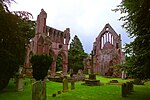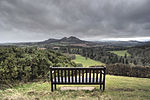Dryburgh Abbey Hotel
1845 establishments in Scotland1932 establishments in ScotlandCountry houses in the Scottish BordersHotels established in 1932Hotels in the Scottish Borders ... and 2 more
Houses completed in 1845Melrose, Scottish Borders

Dryburgh Abbey Hotel is a baronial country house, located on the banks of the River Tweed, in Dryburgh about 5 km south east of Melrose in the Scottish Borders. The modern house was first constructed in 1845 and it was converted into a hotel in 1932. It is next to the ruins of Dryburgh Abbey and part of the former churchyard and its burials are within the grounds.The former house had two access lodges, an Upper Lodge and a Lower Lodge.
Excerpt from the Wikipedia article Dryburgh Abbey Hotel (License: CC BY-SA 3.0, Authors, Images).Dryburgh Abbey Hotel
Geographical coordinates (GPS) Address Nearby Places Show on map
Geographical coordinates (GPS)
| Latitude | Longitude |
|---|---|
| N 55.580109 ° | E -2.649261 ° |
Address
TD6 0RQ
Scotland, United Kingdom
Open on Google Maps










